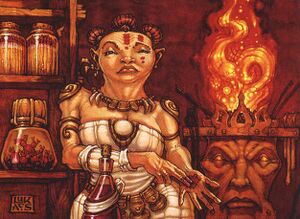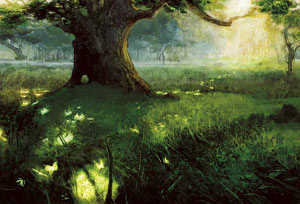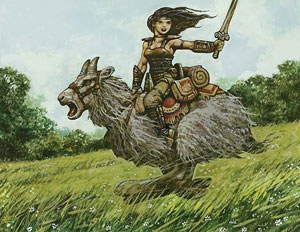The Book of Kith and Kin
| The Book of Kith and Kin | |
|---|---|
| Information | |
| Origin | Lorwyn |
| Status | Last seen on Kephalai |
The Book of Kith and Kin is a collection of stories that is particularly important to the Kithkin of Lorwyn-Shadowmoor.
Description
The Book of Kith and Kin is a tome that holds the collected cultural heritage of all kithkin.[1] After the New Phyrexian Invasion, as many kithkin opened their society to other inhabitants of the plane, the book is regularly updated with new passages as kithkin towns and villages expand to welcome other creatures.[2]
Contents
If one's life is blessed, solutions to all life's problems will appear at the right moment.[3]
On the Nature and Treatment of Boggart Bites

The tooth of a boggart has a magic to it. Boggarts do most of their fighting with rudimentary clubs, slings, or bladed weapons (such as daggers stolen from the Burrenton forges). But a boggart will become desperate and use his natural weaponry, his claws and accursed teeth, if disarmed and cornered. Kithkin flesh will become corrupted by the bite, and special care is required to mend the damage.
Choose eleven green wing-seeds from the north side of a single adult maple tree. Grind them into a fibrous paste between two stones found near where the bite occurred, and squeeze the paste through the afflicted kithkin's handkerchief. Apply the fluid thus derived directly to the bite wound, and repeat at the next dusk and the dusk after. Only then will the boggart's tooth-curse be undone.
The Virtue and Celebration of Springjacks

The springjack has been our choice of riding-steed, our beast of burden, the source of our wool, milk, and mutton, and our race's loyal companion since time immemorial. All kithkin honor the contributions of this regal animal at the annual Springjack Festival. The festivities begin with the lifting competition, where the stoutest kithkin try to lift ever-increasing weights of springjack. There's the joust, a crowd-pleasing show of determination where each kith's jacksmanship is put to the test. Finally, there's the Springjack Reel, a lively, twisting dance symbolic of the story of Talbin Beel, the first kithkin ever to tame a springjack.
The Forge-fires of Burrenton

The great poet Wynnarat once said that Burrenton's fires never need stoking. She was correct, as the great smithing-forges at Burrenton constantly swirl with heat with or without a calloused kithkin hand to poke at the coals. But the forges do need a constant supply of fuel. The forge-tenders' tradition, stretching back to the earliest memories of the elders, is to harvest fallen oak and birch timbers from the border forests and to season the mixture with pebbles from Spinerock Knoll. The magic of the Knoll is undeniable, giving the fuel a durable, consistent heat—but the elders warn not to take too much at a time.
Ribbon-tearing at Lammastide

Long ago, two young kithkin brothers peered into a marsh to discover why its waters were so murky and still. As they looked, an elemental of absolute dread looked back, and touched their minds with evil. For a year and a day thereafter, the brothers dreamed of dark tendrils twining around their souls, binding their minds and crippling their sense of thoughtweft. Then, at the Lammastide holiday, the wise cleric Harrick Teeg broke the spell. He wrapped enchanted cloth ribbons around the brothers, then sliced them away, freeing the brothers from their dreadful dreams.
That is why we kithkin tear ribbons at Lammastide.
The Elementals and Their Omens

He who studies the movements of the elementals learns the workings of the world. Kithkin sages at Dundoolin have recorded elemental omens for generations in an illustrated manuscript called The Eightyfold Trail. The Trail describes and catalogs the eighty distinct categories of elementals and illuminates the meanings of their actions.
The most famous passage of The Eightyfold Trail concerns a substance called moonstone, which is said to aid in a kithkin's augury when studying elementals in the wild. But no substance matching its description has been found; the substance may no longer exist, or the term may be a mis-transcription from earlier copies of the Trail.
Concerning Plovers and Their Tack

The plover is a sturdy, determined beast, but can be intractable. When tacking up a plover, use the bird's singlemindedness against it. Use a rind gourd (especially one coated in bitterberry jam) to attract its attention, and while it eats, affix the saddle to its back and buckle it tightly under the chest. Bring the halter under its beak and loop it over while it swallows pieces of the gourd. Unlike springjack saddles, plover saddles have no stirrups; your ploversquire's job is to guide your weight up onto the seat. If you have no squire, you can use your longspear to help you climb into the saddle; push off with it like a cane, dig your near-side boot into the tough feathers of the haunch, and pull the rein from the far side of the bird. You'll be up in the saddle in a wink.
The Cenn's Sword

Daranna Gwal was Dundoolin's cenn when the Belltower crumbled. Daranna was an honored leader of the clachan, one of the most popular in memory, and an expert swordkith. But when she fell injured in battle, and delirious boggarts got past her to destroy the beloved Belltower. Although she slew the warren's Auntie, she lost pride in her leadership. From her recovery-bed she named Hyal Lwellen her heir, willed him her precious sword, and died soon after.
Hyal took up Daranna's sword, accepting the role of cenn of Dundoolin, and went on to become its most famous cenn of all. Among his acts during his tenure, he had the Belltower rebuilt, set up trade holidays with the Paperfin merrows, and established the first school devoted to elemental study. But Hyal's most famous act was to disband the Dundoolin Raiders, a militia that was used to invade boggart warrens.
Hyal wore Daranna's famous sword on his hip every day, but his greatest wisdom was that he never wielded it.
On Proper Balloonistry

The wind carves an aerial road through the sky, and the balloonist is the kith who roams it. But this road changes moment to moment—it can veer sharply or reverse course without notice. So the balloonist must keep his hands firmly on the lashings and guide the craft without fail.
The great poet Wynnarat once called the balloonist "the eyes of the clachan." Without the balloonist's observations, the thoughtweft would be blind to marauding dangers, such as giants and ornery elementals. The balloonist's aerial freedom is both the key to his skill and the source of his responsibility.
The Alchemist's Rings

As any kithkin alchemist will tell you, the circle is a shape of power. It is the shape of the center of the eye, the concentric pattern in a treefolk's heartwood, and of course the sun's disk. Faeries are attracted to circle shapes, such as rings of flowers and toadstools. And the circle is the key to kithkin powder-magic.
Use a circle of appleseed powder to invigorate crops, or a circle of ground whiskergill bone to ensure a bountiful catch at the river. Master alchemists can construct a binding ring, capable of holding a prisoner at bay for days, with nothing more than a circle of maple sugar. The most sacred of circles is the clachan wreath, under whose power no kithkin village may ever be destroyed.
The Knights of Meadowgrain

Once a year, each clachan sends its most worthy knight to meet on Meadowgrain Lawn, a sanctified clearing a half-day's ride from Kinsbaile. The hopefuls engage in a series of tests to prove their valor, grace in combat, and jackmanship. The winner of the contests is inducted into the Knights of Meadowgrain, the most respected order of kithkin knights in the world.
The Knights of Meadowgrain have a reputation for being mute, but this is not true. It is the knights' custom, however, not to speak for a time after a battle or great personal victory, to emphasize the principle that their acts of honor and bravery speak for themselves. The first cenn of Burrenton was such a knight, and led the clachan for its first fortnight using only nods and gestures.
Branhald and the Moonglove Maiden

Branhald of Goldmeadow was a painter who took his inspiration from nature. He painted in pollen-mixed pastes on canvases of fine milkmoth silk. One day Branhald ventured deep into the woods to find a subject for his masterpiece, and happened upon the most beautiful woman he had ever seen. She was an elf, a creature of extraordinary beauty, and Branhald was sure she would be perfect for his masterpiece. However, she dashed away before he could paint her. He was heartbroken.
Branhald searched for days for the elf woman, crisscrossing the forest where he first saw her. When he finally reached her, she held a vial of liquid, and told him he could only paint her if he used that substance in the painting. He obeyed her wishes and created his masterpiece from her visage—but dropped dead soon after finishing it. The painting, called The Moonglove Maiden, can be seen in Kinsbaile, and to this day the elves' poison has been known as moonglove.
The Companionship of Giants

The curse of the giant is his one-track mind. Some believe it's due to the size of their thoughts; that giants have thoughts so large that only one can fit into a giant's head at a time. Although we kithkin understand that many races lack the collective consciousness of the thoughtweft, the giants' plight, with their slow chain of solitary thoughts, seems particularly dire.
However, this does not stop giants from being powerful allies. When a giant fixates on one of the kith, it may be weeks before the giant's fascination fades, so take advantage of it while it lasts. The benefits of a giant's camaraderie usually greatly outweigh the danger of its company.
Family, Home, and Militia

Although some clachans maintain a standing defense force of knights and soldiers, most villages rely on their peasant militia to defend them from outside threats. As a kithkin can be overwhelmed in single combat by many of the other races and creatures of Lorwyn, the most important principle behind a peasant militia is unanimity. The clachan stands or falls on the will of the people to defend it; any hesitancy on the part of some individual becomes a chink in a clachan's armor. When the thoughtweft communicates danger to a kithkin's mind, she is no longer a civilian, but part of a family of soldiers.
The Sun and Sling-stones

As our world's day ends, the sun arcs down and grazes the horizon in the west. As we sleep, the dim sun ambles along the mountain ridges in the distance and curves around to the eastern horizon. Then in the morning, it swings up again, bringing back the full light of dawn.
That eastern horizon holds important magic. Choose fruits from the dawn side of the tree to make preserves with healing properties. Gather wool from the springjack that faces the dawn's light to spin thread with extra resilience. Choose sling-stones from the dawn side of the river for missiles that fly fastest and farthest.
The Valiant Daggerdare

"Death, visit me first" is the maxim of the daggerdare, the kithkin who has dedicated her life to protecting her fellow kith. Daggerdares use the thoughtweft to detect the mental, physical, and emotional state of their charge, and react instantly to come between that charge and any danger. Most daggerdares these days use wide bronze daggers in both hands, as they consider it most useful to meet danger head-on. However, in times gone by, they have used broad shields for the same purpose.
In-game references
- Quoted or referred to:
- Poems for Kith and Kin:
Behind the scenes
| “ | Hello! Doug here. You've discovered a secret mini-article, within this mini-book, within this article. If you were enjoying The Book of Kith and Kin, great–just spin again and you'll get back to the flavor. But while you're here, I'd like to tell you a bit about how the flavor text of Lorwyn's kithkin came to be.
There are many types of flavor text–the pithy observation, the clever witticism, the dry encyclopedia entry, the trash-talk quote, the bad pun, and a lot more. But the type of flavor text that does the most creative work in a Magic set is what I call world-building flavor text–the kind that expands on the details present in a setting's style guide and makes you feel that you're in the world of the setting. World-building flavor text has a unique job. It's not storytelling, but it shares a lot of characteristics with telling stories; it is fictional text, it often has characters and/or dialogue, and it can certainly get across a moment in time. But stories have a beginning, a middle, and an end. Flavor text is at best a few lines on the card, so it just doesn't have the room to convey an entire story. So what is it? What I most often tell people is that world-building flavor text is a written snapshot that creates a sense of place. The word "snapshot" implies that it isn't trying to give a lot of context or portray long series of actions over time, but rather that it captures the experience and emotions of one moment. The phrase "sense of place" means that its main job is to put the reader into the world in which the creature, spell, object, or location represented by the card belongs. (This kind of flavor text works well on a Magic card, because it so often matches the goal of the card's art–Magic art is also a snapshot of a particular time and place designed to evoke the setting and its denizens. Together they endeavor to synch up your imagination with that of the game's creators, so that we're all participants in the same world.) Writing world-building flavor text is hard work. Today you're seeing the kind of thought process that goes into it. Each "page" of The Book of Kith and Kin is an extrapolation of the thought process behind one piece of world-building flavor text or piece of text in the style guide. Although I wrote these extrapolations, the ideas here are not mine alone–credit is due to the flavor text writers for Lorwyn and to the world-building writers who contributed to the Lorwyn style guide. As you flip through The Book today, you might take a moment to think about their behind-the-scenes efforts, and how they worked to create a sense of place for Lorwyn and the kithkin who live there. |
” |
—Doug Beyer[1] | ||
External links
- Doug Beyer (November 7, 2007). "The Book of Kith and Kin". magicthegathering.com. Wizards of the Coast. Archived from the original on 2020-08-05.
References
- ↑ a b The Book of Kith and Kin (archived)
- ↑ Neale LaPlante Johnson, DK Billins, Laurel Pratt (September 26, 2025). "Planeswalker's Guide to Lorwyn Eclipsed". magicthegathering.com. Wizards of the Coast.
- ↑ Flavor text of Idyllic Tutor (Morningtide)
